Auke Visser's International Esso Tankers site | home
LOOKING BACK IN TIME ( MANHATTAN )
The concept of ice class tankers is not new
 Way ahead of its time, Manhattan breaks the ice.
Back in 1969, an ABSclassed 1962-built twin screw 115,000 dwt tanker Manhattan was rebuilt to undertake two uni-que passages through the Northwest Passage.
One of the main reasons for the experiment was that oil had been discovered at Prudhoe Bay on Alaska's North Slope a year earlier.
This privately funded project, estimated at $54 mill, involved four shipyards, an international team of experts and three oil majors. Once oil had been discovered, Humble Oil, a subsidiary of Esso, (now Exxon) sparked a national debate whether to transport the oil from Prudhoe Bay by pipeline or by specialised ice breaking tankers.
It was decided to convert the Manhattan, which had been built during the changeover from empirical, experienced-based design to first principals engineering aided by the new fangled computer. As ABS put it, the ship combined the daring size of the future with the conservative robustness of the past.' Esso provided the primary financial back-ing with BP and Arco supplying additional funding for the project.
She was built by Bethlehem Steel and was fitted with a steam turbine propulsion system giving 43,000 shp, meaning she had considerably more horsepower per deadweight tonnes than any other commercial vessel afloat.
Its short tank length gave the tanker a substantially greater rigid structure than was found in more modern designs.
Her scantlings were so heavy that the bottom plating, deck and upper hull structure were of normalised, or heat-treated steel, which by nature had very favourable low temperature characteristics.
In December 1968, a team from Wärtsilä approached Esso and offered to share everything they new about ice breaking technology. At that time Wärtsilä was the world leader in this particular sphere having built 60% of the world's icebreaking fleet.
This experiment lasted for 20 months. Wärtsilä advised on the project at virtually every step - from vessel conversion to testing and finally to the modelling and design of future ships for transiting the Northwest Passage.
When the project was approved very little was known about the extent of work needed to convert the Manhattan for Arctic trading.
Only one shipyard, Sun Shipbuilding of Chester (Pa) was willing to take on the conversion work. This had been tend-ered only as 'extensive modification' requiring the strengthening of the hull and the installation of an icebreaking bow, propellers and rudder protection.
The project proved so big that to complete within the set time frame, Sun suggested that four shipyards be used, thus:
- The 493 ft aft section remained at Sun for modification.
- The 122 ft forward section was taken by Newport News.
- The 264 ft mid-body went to Mobile's Alabama Dry Dock.
- The icebreaking bow was built in two sections - one at Sun and the other at Bath
All the work was undertaken under the watchful eye of ABS' surveyors.
In addition, transverse bulkheads were strengthened by adding doublers, installed in way of the welded connections of horizontal girders, while heavy I-beams were placed at every web frame across the width of the ship.
A 9ft-wide sloping steel belt, similar to a large triangular blister in shape, was added to the Manhattan's sides to increase strength and to deflect the deadly pressure ice typically found in the region. The ice belt actually came in useful during the second transit when the sloping sides caused the ice boulders to fall back and away onto the ice flows.
Other modifications included the fitting of a helideck; the renewal of the shafting with higher strengthening materials;
the attaching of a shearing coupling to protect the lowpressure turbine rotor against the shock of ice loads; installing
underwater rudder guards and higher strength propellers; building a double hull for the machinery and steering gear
rooms; reinforcing the machinery for extra stability; and installing a special 'liquid phase' heating system to circulate heated oil to warm the deck machinery. Every modification was proved to be necessary during the transits.
The most distinctive feature of the 'new' Manhattan was her new bow. It was a design that had not seen the light of day before, but still influences icebreaker design today. Its forepart was sloped by 18 deg, curving gently down to
her bottom where it was plumb.
Another innovation adopted following the successful Manhattan project was for forward shoulder, which was the area where the bow section met the ship's parallel body. It was made several meters wider than the hull to cut a wide swathe through the ice and reduce friction on the vessel. When this system was adopted on later icebreakers, it was called a reamer.
On her first 4,400 mile voyage in the late summer of 1969, Manhattan had 126 people on board, of which 45 were crew.
The rest were mainly scientists, journalists and politicians. The Polar pack ice can exceed 3 m thickness. It drifts around in vast floating plains, which can be miles across. As they crash into one another, the floes form huge rubble hills and undersea ridges, some of which can reach 30 m deep.
To pass through this type of ice, a traditional icebreaker rams, rides up and breaks through by pressing down on the ice.
By using this method, Manhattan broke through thicker ice than any other ship before her. She carried no cargo on her first voyage. However, her tanks were filled with water to simulate a laden tanker. Esso then sent the vessel on a second transit the following April to test her against Arctic Winter ice. Unfortunately, she encountered very thick ice,
which she could not break through into the Northwest Passage. Instead, she went to Pond Inlet, near the top of Baffin
Island, where icebreaking tests were conducted to gather additional data.
During the voyages, Manhattan was fitted with all kinds of instruments with strain gauges throughout the hull and the most the time. They were housed in a container on deck.
Following the voyages, a model of the Manhattan was built in Wärtsilä 's new ice model basin. This was constructed
specifically to support the whole project but became instrumental in Finnish/Soviet co-operation on the subject of ice technology.
Voyage data was compared with the model tests and calculations to calibrate the basin and its test results were la-ter used by Wärtsilä and Esso to design further ice class tankers.
This programme proved conclusively that it would be technically and commercially feasible to undertake year round
transits by tanker through the Northwest Passage. However in 1970, the experiments were suspended in favour of a pipeline solution for the export of North Slope Oil.
As for the Manhattan, she was originally built for Niarchos and when delivered in January 1962 was the largest ship afloat. However, as happened in those days this distinction didn't last long as the world's tanker fleet got bigger and bigger, both in terms of numbers and size of vessels.
Apart from carrying crude oil, she was even used to lift grain aid cargoes in the mid 1960s often to Bangladesh. Following her Arctic adventures, she returned to the grain trades for several years until she returned to Alaska in 1977 to load at Valdez for the west coast US refineries.
However, she came to an untimely end in 1987 when a typhoon drove her aground in the Far East and she was scrapped still sporting her distinctive ice breaking bow.
 Manhattan's unique icebreaking bow paved the way for icebreaking technology.
|